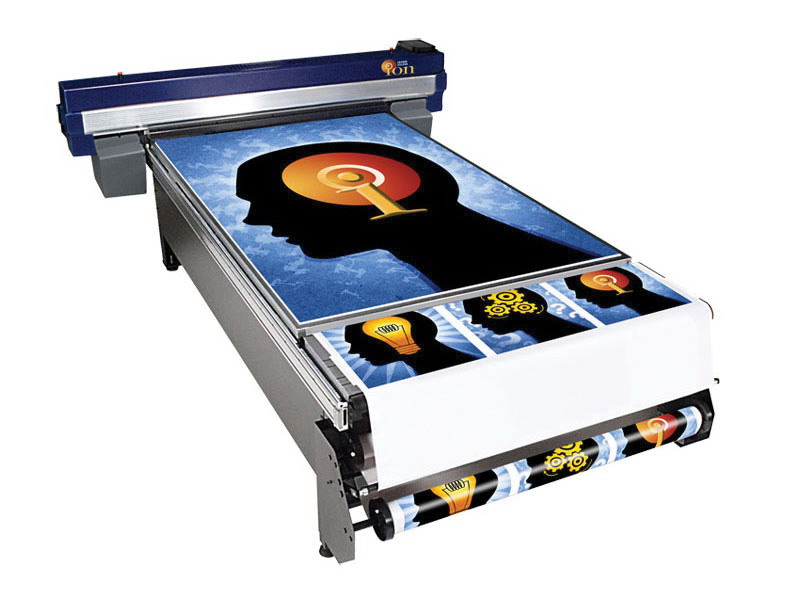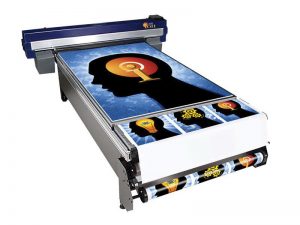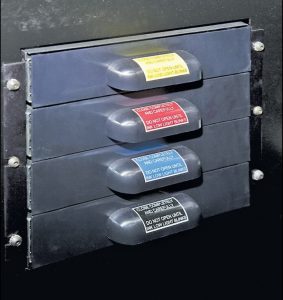Digital Printing
Technology Review: Gerber’s Solara Family of Cationic-Ink, UV-Cure Printers
Published
14 years agoon

T o print on rigid materials, you have essentially two choices: to screen or UV-cure print. Because we write primarily about computer-aided signmaking, we, of course, lean toward the UV-cure printer solution. The technology is mature, proven, and, while prices are not at a commodity level, they have declined as more systems become available.
Also, for many signmakers, UV-cure, flatbed printers seem a more logical choice because printing directly onto a substrate is an excellent method to produce signs. With such a system, you can eliminate the vinyl altogether, major finishing steps and, simultaneously, reduce your operating costs. Hybrid – true flatbed and roll-to-roll – printers make even more sense. Thus, signmaking is easier with flatbed, UV-cure, print processes. You simply load the rigid media into your printer and print directly to the substrate.
A no-brainer, right? Not always. Especially if you choose thin, aluminum blanks as your rigid substrate and the traditional U-cure lamps’ heat causes the aluminum to warp. We’ve seen this happen often, with metal, plastic and film substrates.
Gerber’s ion series
Roughly two years ago, Gerber introduced a new, UV-cure, print system that reawakened an industry buzz-term – cationic ink. Gerber’s GerberCAT™ UV-cure, cationic ink requires much less activation energy and, therefore, generates very little heat. Called a “cold fire cure” system, it’s appropriate for all signage and heat-affected substrates.
All Solara ions use cationic inks, and this greatly expands a signmaker’s available media and substrate range. We’ve written about Gerber’s Solara ion line in the past. Remember? You can start with a basic model and upgrade as your need arises? The latest family member, the ionz is fast, with spectacular print quality. We’ll have more on it in a minute.
The GerberCAT inks
GerberCAT ink offers a broad, color gamut which helps produce intense reds and blues. The gamut’s wide range allows ion-equipped printmakers to produce eye-catching images with a four-color (CMYK) process. Additionally, the inks sailed through our scratch test, plus the inks’ aggressive adhesion properties make them ideal for film, plastic, acrylic and flexible-media applications.
The GerberCAT inks also offer simply unmatched chemical resistance, which fits well with most outdoor applications where the sign may be exposed to harsh conditions.
The difference
So why are the Gerber inks so much different than their competitors? Most UV-cure printer machines use a “free radical” ink that requires significant energy to cure and mechanically bond to media. As we mentioned above, the heat required by many free-radical ink printers can warp thin media, particularly plastic and metal.
GerberCAT inks use a different chemistry, one that doesn’t require the same UV-cure frequency. Thus, the cure lamps operate at a much lower temperature (maximum 85° F on the material surface), which allows you to print on such heat-sensitive materials as paper-based products, thin styrene and corrugated plastic.
The cationic inks require a slightly longer cure time, 0.8 of a second versus 0.2 of a second. Neither is visible to the human eye; the longer cycle improves the inks’ bond to the media. In addition, the longer cure improves ink scratch and chemical resistance.
The Cold Fire Cure system’s lamps run parallel to each side of the gantry. The lamps use less energy and easily outlive traditional, UV-cure lamps. Gerber states a minimum life of 3,000 hours and even covers them under the 12-month warranty and, as well, every year the printer is under service contract.
The Solar ion family
Gerber’s Solara ion printers share a basic structure, and, as mentioned above, you can upgrade from a standard to a more featured version. The three models are the Solara ionV, the ionX and the most recent introduction, the ionZ. Typical of Gerber, the printers are well constructed; they comprise a solid table and a heavy-duty gantry, with a robust, stainless-steel belt and control cable. The gantry-located control panel allows you to manage gantry movements, maintenance modes and other features.
All ion printers’ vacuum tables accommodate flat media that measure up to 5 x 10 ft.; they also accept media up to 1 in. thick, up to 200 lbs. All are four-color machines that apply vibrant cyan, magenta, yellow and black inks. You load the bagged inks into convenient, side drawers.
The main interface connection is an Ethernet TCP/IP port. Power requirements for the printers are 230/240 VAC, 50/60 Hz, 20 A, single phase. The printers’ dimensions are roughly the same – 104 in. wide x 54 in. high x 147 in. deep.
The Solara ionV
Gerber’s ionV, a UV-cure flatbed printer, has four printheads that issue 42-pl dots at resolutions up to 720 dpi. The machine’s nine print modes allow various speeds and resolutions. The print speeds depend upon your resolution choice. For production printing, the two-pass, uni-directional, print mode will image a 4 x 8-ft. media sheet in 14 minutes at 360 x 360 dpi, which is suitable for distantly viewed outdoor signs.
The Solara ionX
If the ionV is not fast enough, or if your shop often prints flexible media, the Solara ionX, built on the basic ion design, is your choice. All the ionV print modes remain, but this model has double – eight – printheads, which is a duplicate, CMYK ink set that significantly increases the printer’s output speed. The ionX will print the same 360 x 360-dpi, two-pass, uni-directional print mentioned above in seven minutes, as opposed to 14. The “best quality” run isn’t a speed demon, but completes in almost half the time mentioned above.
In addition, Gerber added a roll-feed/take-up mechanism to the flatbed table, which makes it a hybrid printer that accepts both rigid substrates and 63-in.-wide roll media that weighs up to 100 lbs.
The Solara ionZ
Gerber felt a logical next step would be to increase the ion’s print/image quality, so, with the ionZ, it introduced a new printhead that produces a significantly smaller drop size.
The ionZ features eight printheads with a 14-pl drop size, which is significantly smaller than its predecessor, the 42-pl ionx but with the same 720 x 720-dpi resolution. The smaller drop size and finer detail provides higher image quality at the same speeds as the ionX.
Further, Gerber engineered and installed a multi-layer ink deposit process that causes more ink to be pushed through the 14-pl printheads. Therefore, you get nearly the vibrancy of 42 pl, but retain the finer detail of the smaller 14 pl. And, because the denser ink retains color when backlit, it’s an excellent choice for double-sided printing on transparent acrylic and glass.
Conclusion
The Gerber Solar ion printer family is unique to the UV-cure marketplace in numerous ways. The cationic inks produce vibrant images with impressive adhesion and flexibility. Low-energy UV-curing lamps save money and offer a broader range of media options. Add the start-small-and-grow approach that Gerber offers with this printer line, plus the flexible-media option, and you can upgrade to the 14-pl heads and produce high-quality images. It’s your choice, but, nicely, you don’t have to buy the entire rig on the first day.
Key Information
Gerber Scientific Products
83 Gerber Road West
South Windsor, CT 06074
(860) 648-1515
(860) 648-8595
www.gspinc.com
Company Profile: Gerber Scientific Products, founded in 1980 as a subsidiary of Gerber Scientific Inc., is a developer and manufacturer of computerized-signmaking and specialty-graphics systems, software, materials and accessories. Gerber also develops and supplies quality, state-of-the-art, aftermarket materials to maximize equipment performance and output.
Contact: Curt Brey, executive director digital solutions; (860) 648-4123; curtis.brey@gspinc.com
At a Glance: The Gerber ion family of printers allows you to start with a basic system and upgrade as your needs expand. The three, Solara ion, flatbed machines, with an optional, roll-to-roll, flexible, media-print system, use a cold-fire, UV-cure, cationic-ink system that permits general signmaking, vehicle graphics and printing on media that may warp under the hotter lamps of other UV-cure systems. The newest ion printer, the 720 x 720-dpi Solara ionZ, features eight printheads with a 14-picoliter drop size. It prints at impressive speeds and also features Gerber’s new multi-layering ink deposit (MLID) process , for increased color output for applications such as backlit, or any job that needs accurate color representation.
Advertisement
SPONSORED VIDEO
Introducing the Sign Industry Podcast
The Sign Industry Podcast is a platform for every sign person out there — from the old-timers who bent neon and hand-lettered boats to those venturing into new technologies — we want to get their stories out for everyone to hear. Come join us and listen to stories, learn tricks or techniques, and get insights of what’s to come. We are the world’s second oldest profession. The folks who started the world’s oldest profession needed a sign.
You may like
Advertisement
Subscribe

Magazine
Get the most important news
and business ideas from Signsofthetimes Magazine.
Advertisement
Most Popular
-

 Tip Sheet1 week ago
Tip Sheet1 week agoAlways Brand Yourself and Wear Fewer Hats — Two of April’s Sign Tips
-

 Photo Gallery2 days ago
Photo Gallery2 days ago30 Snapshots of the 2024 ISA Sign Expo
-

 Ask Signs of the Times4 days ago
Ask Signs of the Times4 days agoWhy Are Signs from Canva so Overloaded and Similar?
-

 Real Deal1 week ago
Real Deal1 week agoA Woman Sign Company Owner Confronts a Sexist Wholesaler
-

 Benchmarks6 days ago
Benchmarks6 days ago6 Sports Venue Signs Deserving a Standing Ovation
-

 Women in Signs1 week ago
Women in Signs1 week ago2024 Women in Signs: Megan Bradley
-

 Photo Gallery1 week ago
Photo Gallery1 week ago21 Larry Albright Plasma Globes, Crackle Tubes and More
-

 Women in Signs1 week ago
Women in Signs1 week ago2024 Women in Signs: Ashley Borell












